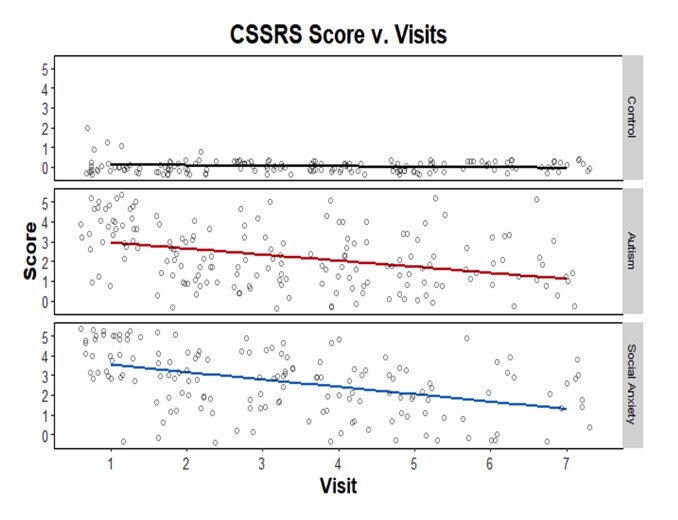Intro
Suicidality poses an escalating public health concern, particularly within the neurodiverse community. Research indicates higher rates of suicidality among individuals with Autism Spectrum Disorder (ASD) (Demirkaya et al., 2016; O’Halloran et al., 2022) as well as those with social anxiety ( Leigh et al., 2023). While the exact causes of heightened suicidality in those with ASD remain unclear, efforts are underway to address the issue through diverse treatments. Some of these treatments, proven effective in neurotypical individuals, are not widely utilized within neurodiverse populations. Contrary to the prevalent misconception that discussing suicidality amplifies its prevalence one known approach to reducing suicidality is open dialogue (Quinnett, 2023; Dazzi et al., 2014). Knowing that suicidal tendencies are decreased by talking about suicide, we set out to answer the question: Is the same true for neurodiverse populations who are at more risk for suicide?
Methods
A group of 72 participants was enlisted for our study, comprising 27 individuals from the ASD community, 20 with social anxiety, and 25 neurotypical individuals serving as a control group. To address our research question, we distributed nightly surveys, delving into inquiries about suicidality, and scheduled their presence every 6 weeks for the administration of the Columbia Suicide Severity Rating scale. During the initial visit, participants underwent the lifetime version, followed by the 6-week version in subsequent visits. Subsequently, we collated the scores and subjected them to analysis using the R programming tool.
Results

We found a relationship between asking about suicidality and decreasing suicidality scores.
ASD: p-value- 0.00, regression= -0.31 Social Anxiety: p-value=0.0, regression= -0.37, Control: p-value= 0.00, regression= -0.02
Discussion
The results show that there is a relationship between decreasing suicidality and asking weather one is suicidal or not. This finding can have implications for future treatments within populations with Autism and Social anxiety.
While longitudinal, not every participant took every survey. This non-participation means that the intervention (asking about suicidality) was not applied daily. Thus, we cannot conclude that asking about one's suicidality decreases it until further statistics are run. In addition to this, we must take when this study was completed into consideration. This study was completed from late 2019 to early 2022. The COVID-19 pandemic was over this time period and the world went through multiple public health initiatives throughout this time. These initiatives, while needed, affected many participants mental health. Many of the weaknesses can be accounted for through replication.
Further research is needed in this area. If the results of the research concur with the findings of this study, then suicide prevention programs can be applied to these populations with more backing. Additionally, more suicide prevention programs can be created surrounding this research for these populations.
Overall, this research, although limited in some ways, is promising for suicide prevention for both populations with social anxiety and autism.
Citations
Dazzi, T., Gribble, R., Wessely, S., & Fear, N. T. (2014). Does asking about suicide and related behaviors induce suicidal ideation? What is the evidence?. Psychological medicine, 44(16), 3361–3363. https://doi-org.byu.idm.oclc.org/10.1017/S0033291714001299
Demirkaya, S., Tutkunkardaş, M., & Mukaddes, N. (2016). Assessment of suicidality in children and adolescents with diagnosis of high functioning autism spectrum disorder in a Turkish clinical sample. Neuropsychiatric Disease and Treatment, 12, 2921 - 2926. https://doi.org/10.2147/NDT.S118304
Leigh, E., Chiu, K., & Ballard, E. D. (2023). Social anxiety and suicidality in youth: A systematic review and meta-analysis. Research on Child and Adolescent Psychopathology, 51(4), 441–454. https://doi.org/10.1007/s10802-022-00996-0
O’Halloran, L., Coey, P., & Wilson, C. (2022). Suicidality in autistic youth: A systematic review and meta-analysis. Clinical Psychology Review, 93, 1–17. https://doi-org.byu.idm.oclc.org/10.1016/j.cpr.2022.102144
Quinnett, P. G. (2023). The certified QPR pathfinder training program: A description of a novel public health gatekeeper training program to mitigate suicidal ideation and suicide deaths. Journal of Prevention, 44(6), 813–824. https://doi.org/10.1007/s10935-023-00748-w
Other Helpful articles that are related to the subject
Cigularov, K., Chen, P. Y., Thurber, B. W., & Stallones, L. (2008). What prevents adolescents from seeking help after a suicide education program? Suicide and Life-Threatening Behavior, 38(1), 74–86. https://doi.org/10.1521/suli.2008.38.1.74
Chung, M.-L., Forstner, A. J., Mücke, M., Geiser, F., Schumacher, J., & Conrad, R. (2022). Predictors of suicidal ideation in social anxiety disorder—Evidence for the validity of the Interpersonal Theory of Suicide. Journal of Affective Disorders, 298(Part A), 400–407. https://doi.org/10.1016/j.jad.2021.11.017
Litteken, C., & Sale, E. (2018). Long-term effectiveness of the question, persuade, refer (QPR) suicide prevention gatekeeper training program: Lessons from Missouri. Community Mental Health Journal, 54(3), 282–292. https://doi.org/10.1007/s10597-017-0158-z
Mann, J. J., Michel, C. A., & Auerbach, R. P. (2021). Improving suicide prevention through evidence-based strategies: A systematic review. The American Journal of Psychiatry, 178(7), 611–624. https://doi.org/10.1176/appi.ajp.2020.20060864